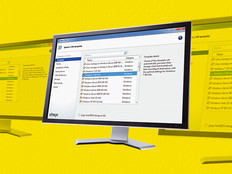Schools Power Up with an Uninterruptible Supply
College IT departments deploy UPS systems to maintain high availability and protect their data centers from power outages.
Maximum uptime, especially in the event of a power failure, is a top priority for the data center pros at the College of DuPage in Glen Ellyn, Ill.
“Our goal is 100 percent availability to students and users,” says Sandra Geis, manager of systems and operations at the 31,000-student school, the largest community college in Illinois.
The centerpiece of the school’s high-availability strategy is a new 120-kilovolt-ampere (kVA) uninterruptible power supply from Eaton and a backup generator.
The UPS replaced one the school purchased in 1990 when the data center consisted of a single mainframe. Now, in addition to the mainframe, the data center includes 90 servers. The old UPS could still maintain service in the event of an outage, but burdened with the need to protect more servers, its performance was declining.
“As the data center brought in more equipment, the amount of time the UPS would continue to power the data center in the event of an outage kept dropping,” explains Keith Conlee, chief security officer for the IT department at the school.
The specific runtime for the old UPS varied depending on how recently the batteries had been changed, but Geis estimates that optimally it could run for about one hour, compared with three to four hours for the new UPS.
69% of data managers rate high availability as their top priority.
Source: Data Center Users Group
Not that she needed it to run that long. Because the backup generator takes only about two to three minutes to kick in, the old UPS still had the data center covered. But when your goal is 100 percent availability, you can’t afford to rely on just one device.
“We wanted to make sure that if our generator didn’t start, our users could count on at least a few hours of uptime,” Geis says. She adds that in her area, unplanned power outages of more than two hours are extremely rare.
Managing Power
Colleges and universities use UPS systems to protect their information systems against a host of power-related issues. IT managers can condition power to smooth out spikes; protect against lightning strikes; and either keep systems running or initiate an orderly shutdown during power sags, brownouts or outages.
Teoh Chew Yew, a research analyst with Frost & Sullivan, says that while the economic downturn will reduce UPS sales this year, the movement toward data center consolidation and green IT will be major drivers of the technology going forward.
“As organizations put more eggs in a single basket to save money or go green, they’re going to want to protect that basket,” he says. “A UPS is a relatively inexpensive way to do that.”
Take Bryant University: Rich Siedzik, director of computer and telecommunications services at Bryant, says power issues were not the school’s original reason for buying a UPS. Its main goal was to centralize resources for greater efficiency. Along with a UPS, Siedzik put all the standard disaster recovery safeguards in place, such as a RAID system and fail-over servers. He also uses the capabilities of server virtualization for disaster recovery purposes. Still, Siedzik says, once the school centralized its data center, it could concentrate more on uptime, and the UPS was an important part of that effort.
Before the centralization project, Bryant’s data center was spread out across three locations, all of which were retrofitted classrooms. After centralizing into a data center, the school reduced its server farm from 80 physical machines to 40 virtualized servers.
One advantage of centralization is that the school was able to deploy a large, 80kVA UPS from American Power Conversion. “One large UPS does a much better job of conditioning power than the smaller UPS systems we had,” Siedzik says.
To determine the size of the UPS he needed, Siedzik measured the data center’s average power consumption during peak business hours and added 30 percent more capacity. He chose a modular UPS so that he could upgrade should he decide to expand the number of servers — thus increasing his power requirements — in the data center.
The IT organization then explained the importance of the UPS to the college’s executives. Siedzik says it was important for top management to understand that the UPS was an essential expense, something the school really needed to safeguard its information in the event of a disaster.
The Right Time
Concordia University also implemented a UPS to support a consolidated data center, but in this case, the consolidation came with a relocation of the entire school.
In 1926, when Concordia University Texas was founded, Austin was a small backwater. As the city grew up around the college and downtown real estate prices skyrocketed, developers made increasingly tempting offers to purchase the property. Finally, in August 2008, the school sold its 23-acre downtown campus and used the proceeds to relocate to a roomier, 390-acre site.
The move was significant for information systems. “We actually got a real, centralized, fully planned data center with enterprise-level UPS systems,” says DeWayne Mangan, director of information systems at the school.
At the original campus, the data center had grown some-what haphazardly, with walls being torn down when the school needed to expand. Power was protected (also somewhat haphazardly) by a number of consumer-level UPS systems in the racks. In the event of a failure, the word “sneaker-net” took on new meaning: “When the lights went out, things got pretty scary,” Mangan remembers. “I had seven minutes to sprint across campus to try to shut down the servers before the battery backup also failed.”
While moving a data center is never easy, a new facility does give schools a greenfield in which to build a better power protection system. “We got a do-over, an opportunity to get things right from a technology standpoint,” Mangan says. The facility Concordia bought had a pre-existing 5,000-square-foot data center, which the school reduced to 2,000 square feet.
The first step to sizing the UPS was to estimate power requirements. Mangan says his data center consultant first determined the maximum capacity of the air conditioning units the data center could handle given the available floor space and load capacity. The center’s cooling capability dictated the maximum number of servers and other devices. The consultant then determined that when the data center is outfitted with its maximum server configuration, it would require less than 60kVA. So the school purchased two 30kVA units from Tripp Lite. Configured as A/B units, either one can be taken down for maintenance while the other remains online.
The one blackout the school suffered after the move lasted well over two hours. Maintaining power at 25 percent capacity, Mangan kept the servers up the entire time with about 10 percent battery power left when the lights came back on. Mangan says that outages, especially prolonged outages, are rare in his area, so two hours of backup power is sufficient.
Mangan is seeking ways to increase the effectiveness of the UPS systems as well as the data center’s participation in his school’s green initiative by buying energy-efficient blade servers. He had wanted to buy new servers at the time of the relocation, but the old servers still had a few years of life left, and given the cost of the move, he couldn’t justify purchasing new hardware.
He says one of the most important lessons learned in his UPS implementation is to hire a data center consultant (not an electrician) to estimate power and UPS requirements. And once the consultant develops a plan, don’t let electricians make changes to it.
“General electricians are good at giving you power, but they don’t understand data centers,” Mangan says. “So they can’t balance the need for cooling against power, and they don’t understand how server requirements fit in with backup power requirements.”
A good UPS can be an essential part of a high-availability strategy. It’s important to choose a UPS with the right amount of capacity and number of features, and to develop procedures for shutting down some servers or switching to generator power in the event of power problems. Configured correctly, the right UPS can help a school with everything from spikes to outages.
UPS Checklist
Power capacity. By far, the most important consideration when selecting a UPS is power capacity, measured in volt-amperes (VA) for individual PCs or one or two server units, or kilovolt-amperes (kVA) for enterprise-class UPS systems. Collect data on power usage, add about 30 percent additional capacity, and the result is the size of the UPS you need.
UPS type. The standby UPS, generally small and used with individual PCs, allows filtered AC power to flow directly to the output and switches to battery power when the AC source fails. In the line interactive UPS, often used for small business or departmental servers, the power flows through the battery and is converted to AC power. This provides better filtering than would a standby UPS. The double conversion online UPS is an enterprise-class design generally used in UPS systems above 10kVA. It offers excellent filtering and immediate switchover in the event of a power outage.
Applications. Many UPS systems include an application that lets administrators specify automatic actions in the event of a power spike, sag, outage or other event. For example, the application could automatically shut down a server.
Alarm capabilities. A UPS can report power problems and send alarms to cell phones, pagers or e-mail.






